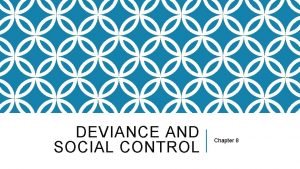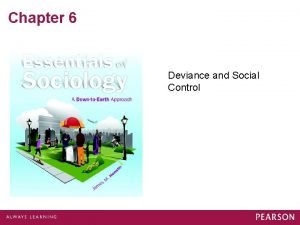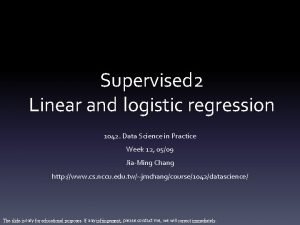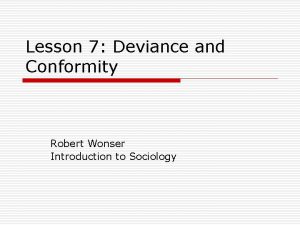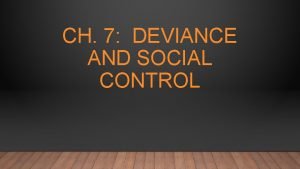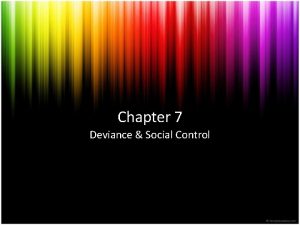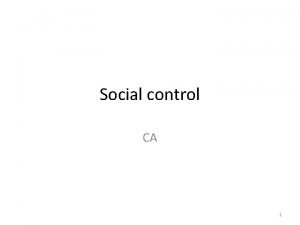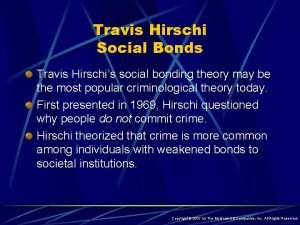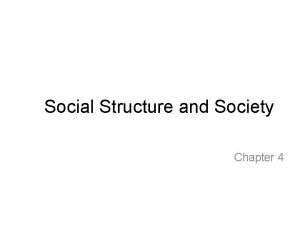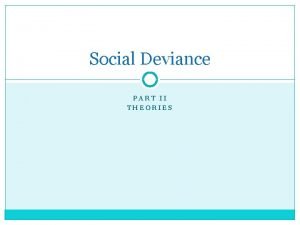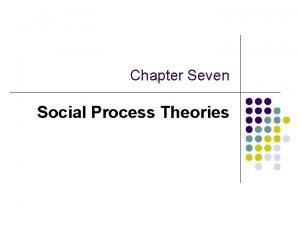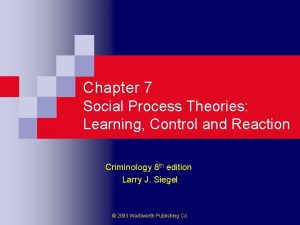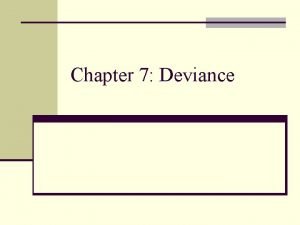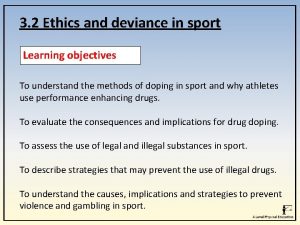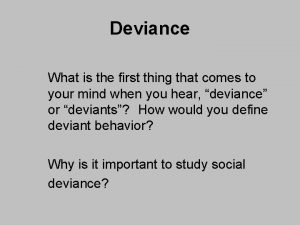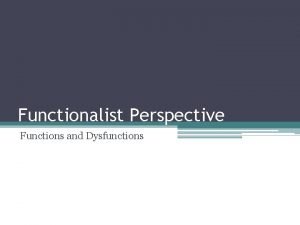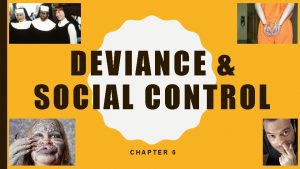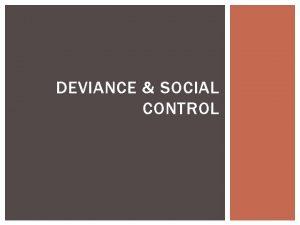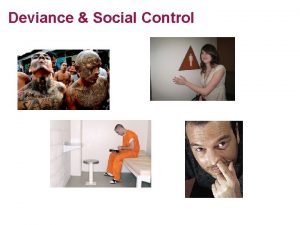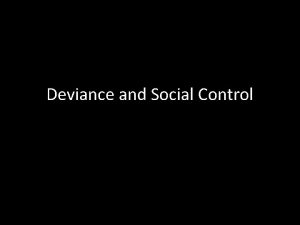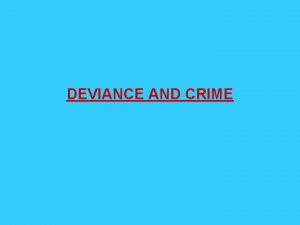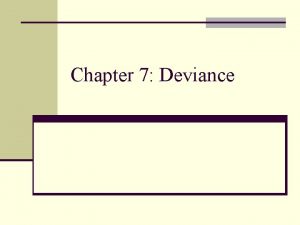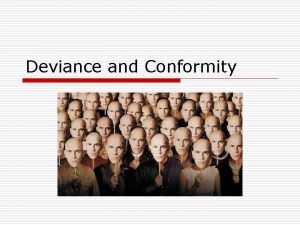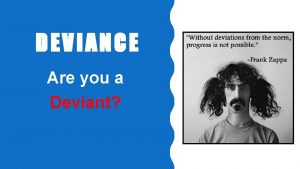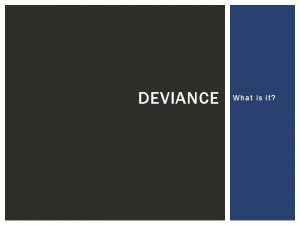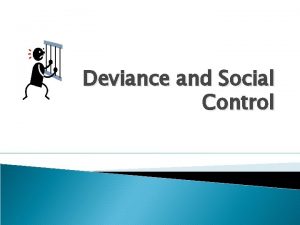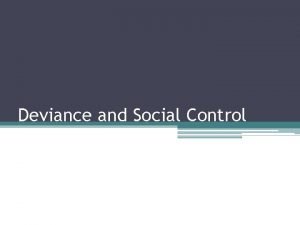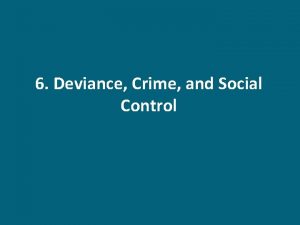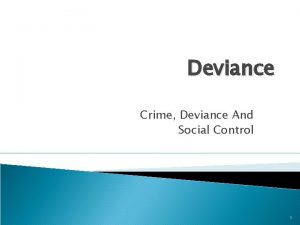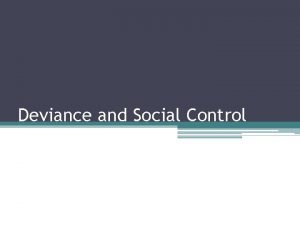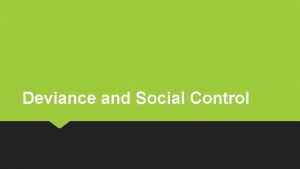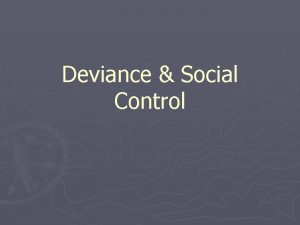Chapter Seven Deviance and Social Control Chapter Overview
























- Slides: 24

Chapter Seven: Deviance and Social Control

Chapter Overview n What is Deviance? n The Symbolic n n The Conflict Perspective Interactionist n Types of Crime Perspective n The U. S. Prison The Functionalist System Perspective 2 Deviance and Social Control

What is Deviance? “It is not the act itself, but the reaction to the act, that make something deviant. ” Howard Becker, 1966 3 Deviance and Social Control

What is Deviance? Deviance is a violation of societal norms What is deviant to some is not deviant to others “Deviance” is a nonjudgmental term Deviance is in the eye of the beholder Examples: Yanomano tribe of Brazil Pokot Tribe (Kenya, Africa) 4 Deviance and Social Control

What is Deviance? Deviance is Relative t t t t Time Place Situation Culture Actors Audience Media 5 Deviance and Social Control

Deviance and Social Control

Norms and Social Life Norms Make Social Life Possible by Making Behavior Predictable Informal Norms and Formal Norms (crimes) Bring About Social Order A group’s customary social arrangements Societies have formal and informal means to enforce norms and this is referred to as Social Control Formal and informal means of enforcing norms. Sanctions 7 Deviance and Social Control

Stigma –Erving Goffman A person can have a stigma and be considered deviant A stigma is a blemish on ones identity A stigma is a violation of norms of appearance and ability A person can have a stigma by being a member of an involuntary group Deviance and Social Control

Sociological Analysis of Deviance t Functionalist t. Social order and Deviance t. Anomie Theory t Symbolic Interactionist t. Differential Association Theory t. Control Theory t. Labeling Theory t. Techniques t Deviance is defined by society and social groups. People’s reactions to behaviors define deviance. t of Neutralization Conflict Perspective t. Power Deviance helps create stability in society. Too much deviance would cause society to be unstable. t and Deviance t. Law as an instrument of oppression Deviance is a consequence of social inequalities. Powerful groups define deviance and control criminal justice system. Powerless groups are usually defined as deviant. t 9 Deviance and Social Control

Symbolic Interactionist Perspective: Differential Association Theory We learn to deviate by those we associate with in our lives—E. Sutherland Deviance is learned through socialization Social group give messages about conformity and deviance. Techniques of committing the deviance Motives, drives, attitudes, and rationalizations for committing deviant acts. This includes family, friends, and neighbors 50 % of people in prison also have a father, mother, brother, or sister that have also committed a crime Prison or freedom? Criticism of Theory Deviance and Social Control

Symbolic Interactionist Perspective: Control Theory Created by W. Reckless We all have strong desires to do things that would get us in trouble —inner drives, temptations, urges, hostilities, etc. We all want to commit deviant acts but we don’t because of inner and outer controls The stronger the controls, the less likely deviance is to occur Inner controls: Conscience, Morals, Religious Beliefs Outer controls: Attachments, Commitments, Involvements in society The stronger the bonds are with these people, then the more effective our inner controls are. If elements are weak, then the individual is likely to commit Deviance and Social Control deviant acts.

Symbolic Interaction Perspective Labeling Theory Labels people are given affect their own and others perceptions of them and channels their behavior either into deviance or conformity Labels become a part of our self concept Primary Deviance Occurs when an individual violates a norm and is viewed as deviant but rejects the deviant label and maintains a conformist conception of herself or himself. Secondary Deviance It is the internalization of a deviant label and the assumption of a deviant role. Deviance as a Master Status Role freezing Role engulfment Career of Deviance and Social Control

Labeling Theory Third Party Enforcer of laws, rules, policies Deviant Career Secondary Deviance Role engulfment Deviant Identity Audience Primary Deviance Deviant Act Role freezing Master Status Deviance and Social Control

Techniques of Neutralization Condemnation of Condemners Denial of Responsibility Denial of Injury Appeal to Higher Loyalty Denial of Victim Deviance and Social Control

Functionalist Perspective Can Deviance Be Functional? According to Durkheim, deviance is functional because: 1) It affirms moral boundaries 2) Promotes Social Unity 3) Promotes Social Change 15 Deviance and Social Control

Functionalist Perspective Strain Theory Robert Merton created the Strain Theory Crime is natural part of society Crime is caused by cultural or mainstream values We are all socialized to want certain cultural goals but we don’t all have the cultural means to attain those goals People develop strain and a sense of anomie (normlessness) 16 Deviance and Social Control

Functionalist Perspective: Responses to Strain Conformity – This is the most common response to strain and is a non-deviant response Innovator – Wants to achieve cultural goals but uses illegitimate methods Ritualism – Has given up on attaining cultural goals but still clings to conventional means of conduct Retreatism – Rejects cultural goals and means to attain those goals Rebellionism – Rejects cultural goals and tries to replace them with own goals Deviance and Social Control

People’s Reactions to Cultural Goals Deviance and Social Control

Conflict Perspective The law is used as a means to oppress the masses Those who have the wealth and power often bypass the law and others must pay full penalties Every once in a while someone from the upper social classes is “showcased” so as to appear fair Focus is on the social inequalities of the criminal justice system The police, courts, and prisons that deal with people who are accused of having committed crimes. Power elite runs society and controls the criminal justice system Deviance and Social Control

Two Types of Crime White Collar Crime Street Crime that is Often committed by those who those of the lower social have wealth and power classes as a way to survive Corporate crime is a type of white collar Includes property crime 20 Deviance and Social Control

The U. S. Prison System The U. S. has the highest amount of prisoners in the world Many prisons face overcrowding The recidivism rate is high; 2/3 of those who commit violent crimes are rearrested The majority of prisoners are male, have a high school education, and are from the lower to middle social classes What should be the purpose of prisons? Deviance and Social Control

22 Deviance and Social Control

Copyright © Allyn & Bacon 2009 23 Deviance and Social Control

Death Penalty Bias Deviance and Social Control
 Chapter 7 deviance crime and social control
Chapter 7 deviance crime and social control Chapter 8 deviance and social control
Chapter 8 deviance and social control Chapter 6 deviance and social control
Chapter 6 deviance and social control Pseudo r-square
Pseudo r-square Deviance avowal
Deviance avowal Social control examples
Social control examples Deadly sins and heavenly virtues
Deadly sins and heavenly virtues Discouraging criminal acts by threatening punishment
Discouraging criminal acts by threatening punishment Formal social control
Formal social control Travis hirschi's social bond theory
Travis hirschi's social bond theory Social thinking social influence social relations
Social thinking social influence social relations Social thinking social influence social relations
Social thinking social influence social relations Crime and deviance sociology revision
Crime and deviance sociology revision Primary and secondary deviance
Primary and secondary deviance Inner and outer controls work against deviance
Inner and outer controls work against deviance Difference between crime and deviance
Difference between crime and deviance Primary vs secondary deviance
Primary vs secondary deviance Social process theories
Social process theories Primary and secondary deviance
Primary and secondary deviance Deviance in sport
Deviance in sport What is primary and secondary deviance
What is primary and secondary deviance Deviant sexual behavior examples
Deviant sexual behavior examples Deviance examples
Deviance examples Marxism crime and deviance
Marxism crime and deviance Dysfunctions of deviance
Dysfunctions of deviance

